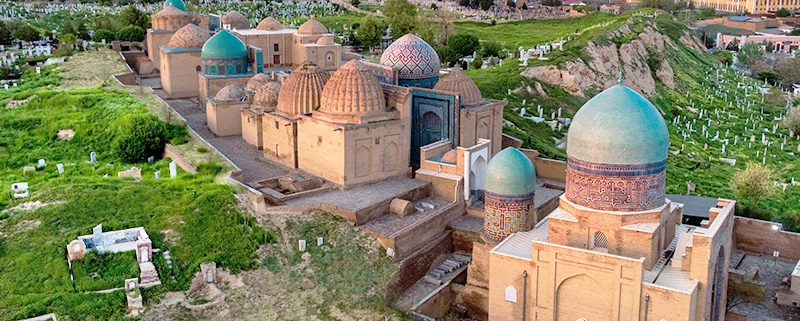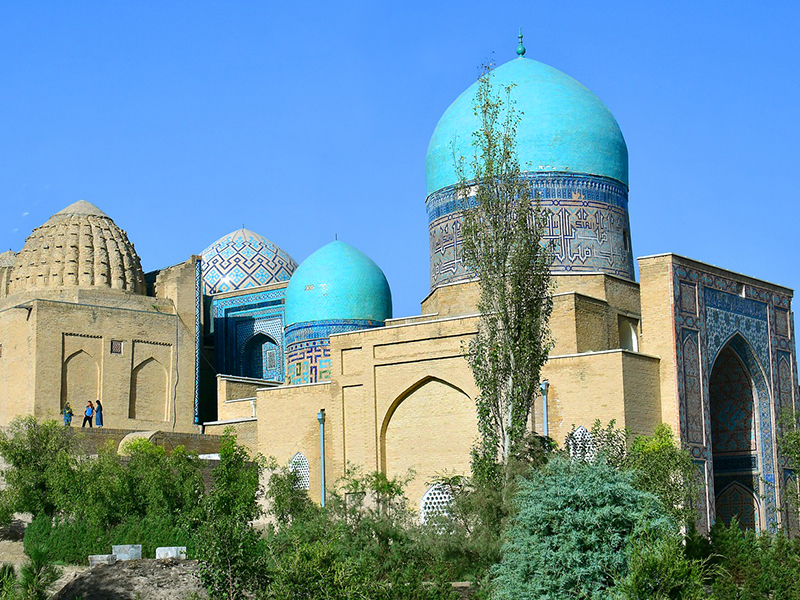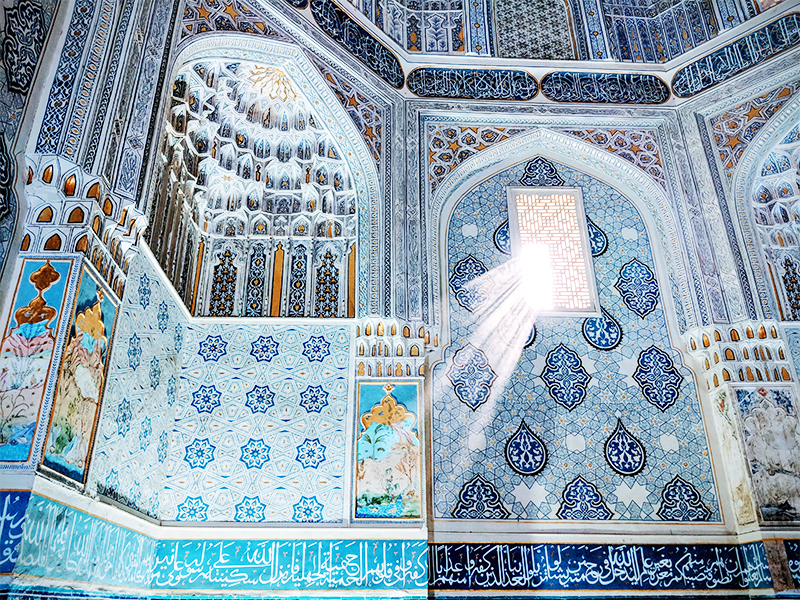Shah-i-Zinda Complex: Photos, Architecture, Opening Hours
The Tomb of Shah-i-Zinda is one of the most famous attractions in Uzbekistan and the most attractive sight in Samarkand. This complex consists of old and colorful buildings with large and beautiful doors. Among these buildings, there are narrow and old streets that add to the beauty of this area and make it look more special. This magnificent historical complex annually hosts many travelers from all over the world.
Shah-i-Zinda History
Shah Zinda is where an important and famous person is buried, Qutham ibn Abbas, and the cousin of the Prophet of Islam. Many stories have been told throughout history about his grave, and some are biased against it.
According to old stories, Qutham ibn Abbas came here in 640, following the Arab attack in the 7th century, to spread Islam, and lived here for 13 years. After some time, Imam Ali, as the governor of Makkah, and Taif chose him. In the year 56 AH, Qutham ibn Abbas went to Khorasan and fought for the cause of Islam across the Nile, spread Islam, and was present in the conquest of Samarkand and Bukhara. After the incursion, he stayed there and propagated Islam.
Along with the spread of Islam, he provided many social services to the people. He built a large mausoleum outside the city and ordered water streams constructed. Thus, everywhere became green and prosperous. He was a benevolent and generous person, and he is well remembered. Finally, he died in this city. Today, this historical place has become an important attraction in the country of Uzbekistan and the city of Samarkand.
Shah-i-Zinda Meaning
Some people believe that after the head of Qutham ibn Abbas was cut off for his beliefs, he took his head in his hands and went to the depths of a well located in this complex and disappeared. The people of Samarkand believe that he is not dead and just absent. According to this narration, the well is connected to a garden where the king lives and will return one day. For this reason, this historical monument is called Shah-i-Zinda, which means the living king.
Different Parts of Shah-i Zinda
The tomb of Shah-i-Zinda is located in a vast area and has different parts. Start your visit from the northern part, which is the oldest part of the Shah-i-Zinda mausoleum, towards the middle and southern parts, which will be explained briefly in the following paragraphs.
Northern Part
The northern part of the mausoleum, which is considered the oldest part of the complex, includes the mausoleum of Khwaja Ahmad, the Summer Mosque, the Gate of Heaven, and the mausoleum of Shah-i Zinda on one side, and the complex of Tuman Aqa (Timur wife) on the other side. The tomb of Khwaja Ahmad, which was built in the 14th century and is one of the oldest buildings in the complex, is a unique masterpiece of glazed tiles. The tiles of this building are white, turquoise blue, and azure. The epitaph of this tomb says: “I hope that God will turn this tomb into a paradise for Khwaja Ahmad with his infinite grace.”
The Shah-i Zinda building was designed and built by Yusuf Sherazi. The beautiful Muqarnas under the dome have a soft turquoise color. In addition to the tiles, the mausoleum also has stepping stones. There is a Quran verse written on the top part of it, describing the cemetery’s name: “Never think of those who were killed in the way of God as dead. No, they are alive!” The wooden door of the complex is a unique masterpiece of Master Shirazi’s carving art.
If you move to the north side of the complex, you will reach the Ali Nasafi Tomb; the inside of the building is decorated with glazed pottery, and the front of this building has multi-colored tiles. The use of turquoise inlays on the polished bricks of the side facades and eye-catching eight-sided stars are the main features of the facade. The names of twelve Shia imams are engraved on the central star.
Passing this part, you reach the middle part of the cemetery, which contains the tombs of Shadi Mulk Aga (Timur’s sister), Amirzadeh (one of Timur’s servitors), Tuglu-Tekin (Amirzadeh’s mother) and Shirin Bika Aga (Timur’s sister). The outside and inside of the building are decorated with relief glazed pottery. The head of the tomb of Shirin Bika Aga is also covered with mosaic tiles and quotes from Socrates, and the dome is decorated with polished bricks with a geometric pattern.
Southern Part
The southern part of the complex is the main entrance of the Shah-i Zinda complex. This section includes the tomb of Kazi Zade Rumi and Abdal Aziz Gate and Quadrangle. The tomb of Kazi Zade Rumi, a famous mathematician and astronomer, who founded the Samarkand Observatory with the help of Ulugh Beg and Giyasiddin Jamshid Kashi, includes a tomb, a pilgrimage house, and four chambers, and has two domes, with a great gate of the tomb under both domes. The southern quadrangle was built in honor of the young son of Ulugh Beg. The quadrangle includes a small mosque, rooms, and annexes in the east, which was built in the late 15th century on the foundations left over from the 12th century. The walls and altar of the mosque are also decorated with mosaic tiles.
Shah-i Zinda Funerary Complex
The tomb of Shah-i Zinda consists of different parts, which concludes that the buildings belong to the 9th, 14th, and 19th centuries. These buildings were built during nine centuries (11th to 19th centuries), and their total is equal to 20 historic buildings. There are three parts to the buildings, the lower, middle, and upper. The newest buildings belong to the 11th and 12th centuries. The stones of all buildings remain intact and can be recognized. One of the most significant parts of these buildings is the tomb of Qutham ibn Abbas, located in the northwest. The oldest of these buildings is also this tomb.
Shah-i-Zinda Architecture
The Shah-i-Zinda complex is a combination of architectural complexes that are located next to each other in different periods of the 14th and 15th centuries; this complex has been identified as a linear cemetery due to the predominant presence of tombs in these complexes. With their bright blue walls and works of art, the tombs have been transformed into incredible works of art and Islamic architecture. This complex consists of old and colorful buildings with large and beautiful doors. Among these buildings, there are narrow and historic streets that add to the beauty and charm of this area.
All tombs have a gate and a dome. The only difference is in the size and shape of the dome beside their decorations. Shah-i-Zinda tiles include relief tiles that are composed of a combination of different shades of blue, azure, and turquoise and have turned this complex into one of the most beautiful tombs in the world.
Shah-i-Zinda Mosque
This complex includes a quadrangle, mausoleum, and mosque, which was built around the 15th century. The outer covering of the building is made of marble tiles and is decorated with eye-catching inscriptions. The interior decorations include mosaic plinths, decorated with gold motifs on enamel, which lead to geometric motifs at the top of the dome. The mosque is in the shape of a rectangular nave and its walls and altar are decorated with mosaics. The development of this complex continued during the time of Ulugh Beg and glazed brick was added to the facade decorations.
Shah-i-Zinda Restoration
The tomb of Shah-i-Zinda, a small minaret, a school, and several tombs belonging to the 11th or 12th century were discovered underground. The tombs were left after the Mongol attack destroyed Samarkand until the construction and reconstruction of the old part began at the end of the 14th century. This building was rebuilt in the period of Timur Gurkani, and for this reason, it is one of the most sacred buildings of the Timur period. The main entrance of the cemetery, which has 39 steps, was also built later in the 15th century, during the time of Ulugh Beg.
Shah-i Zinda Visit Information
The best time to visit this complex is in September and March when the temperature is pleasant.
You need at least an hour to visit these tombs.
Are you planning to travel to Uzbekistan? Read about more things to do in Samarkand and check out our Uzbekistan tour!









Leave a Reply
Want to join the discussion?Feel free to contribute!